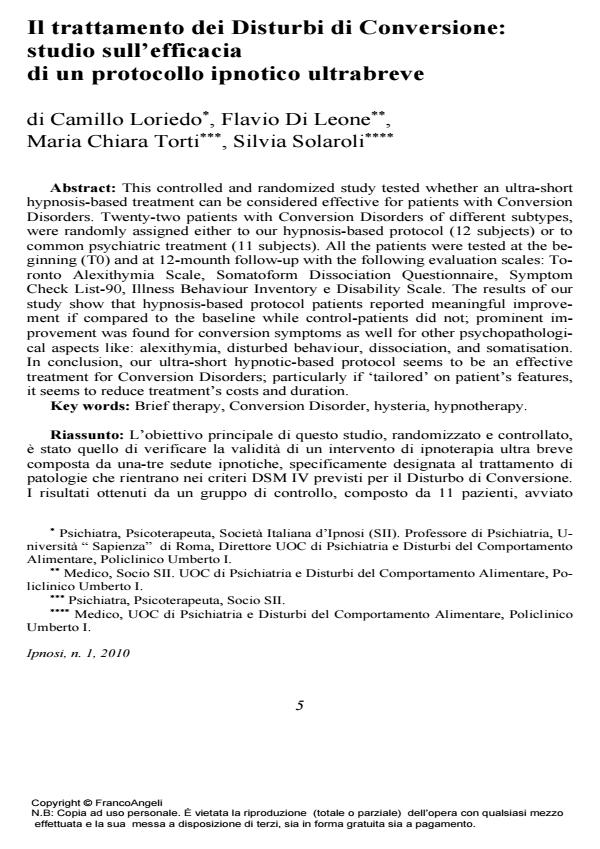Il trattamento dei Disturbi di Conversione: studio sull’efficacia di un protocollo ipnotico ultrabreve
Journal title IPNOSI
Author/s Camillo Loriedo, Flavio Di Leone, Maria Chiara Torti, Silvia Solaroli
Publishing Year 2010 Issue 2010/1
Language Italian Pages 15 P. 5-19 File size 581 KB
DOI 10.3280/IPN2010-001001
DOI is like a bar code for intellectual property: to have more infomation
click here
Below, you can see the article first page
If you want to buy this article in PDF format, you can do it, following the instructions to buy download credits

FrancoAngeli is member of Publishers International Linking Association, Inc (PILA), a not-for-profit association which run the CrossRef service enabling links to and from online scholarly content.
This controlled and randomized study tested whether an ultra-short hypnosis-based treatment can be considered effective for patients with Conversion Disorders. Twenty-two patients with Conversion Disorders of different subtypes, were randomly assigned either to our hypnosis-based protocol (12 subjects) or to common psychiatric treatment (11 subjects). All the patients were tested at the beginning (T0) and at 12-mounth follow-up with the following evaluation scales: Toronto Alexithymia Scale, Somatoform Dissociation Questionnaire, Symptom Check List-90, Illness Behaviour Inventory e Disability Scale. The results of our study show that hypnosis-based protocol patients reported meaningful improvement if compared to the baseline while control-patients did not; prominent improvement was found for conversion symptoms as well for other psychopathological aspects like: alexithymia, disturbed behaviour, dissociation, and somatisation. In conclusion, our ultra-short hypnotic-based protocol seems to be an effective treatment for Conversion Disorders; particularly if ‘tailored’ on patient’s features, it seems to reduce treatment’s costs and duration.
Keywords: Brief therapy, Conversion Disorder, hysteria, hypnotherapy.
- Considerazioni cliniche per una Terapia Ipnotica basata sulle evidenze per le Crisi Epilettiformi Psicogene Flavio G. Di Leone, in IPNOSI 2/2015 pp.5
DOI: 10.3280/IPN2015-002001 - Hypnosis and suggestion as interventions for functional neurological disorder: A systematic review Michael H. Connors, Lena Quinto, Quinton Deeley, Peter W. Halligan, David A. Oakley, Richard A. Kanaan, in General Hospital Psychiatry /2024 pp.92
DOI: 10.1016/j.genhosppsych.2023.12.006
Camillo Loriedo, Flavio Di Leone, Maria Chiara Torti, Silvia Solaroli, Il trattamento dei Disturbi di Conversione: studio sull’efficacia di un protocollo ipnotico ultrabreve in "IPNOSI" 1/2010, pp 5-19, DOI: 10.3280/IPN2010-001001